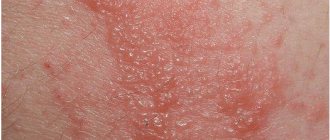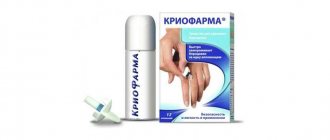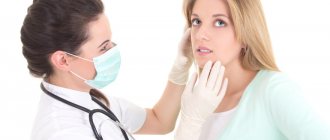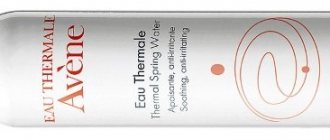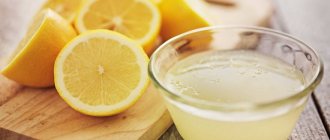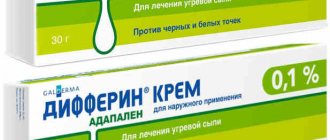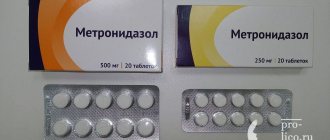Many women are very worried when acne appears on their face.
They especially cause a lot of problems for young girls.
No pimples, even the most inconspicuous ones, add attractiveness to the face, making the skin uneven.
- All information on the site is for informational purposes only and is NOT a guide to action!
- can give you an ACCURATE DIAGNOSIS !
- We kindly ask you NOT to self-medicate, but to make an appointment with a specialist !
- Health to you and your loved ones!
This causes a decrease in self-esteem in girls and the appearance of complexes.
Therefore, they squeeze out the hated blackheads, which often leads to the spread of acne.
Pimples can be different: black and white dots, purulent, red and subcutaneous.
Their development almost always begins in the same way - with blockage of the ducts of the sebaceous glands.
Depending on the characteristics of this process, several types of acne are distinguished.
- When pores become clogged with excess sebum, dead skin cells and dirt, a plug forms. If the mouth of the sebaceous duct is expanded, then the fat oxidizes from contact with air and darkens. A black pimple forms.
- If this plug is subcutaneous, then the oxidation reaction does not occur. The pores are greatly narrowed, so the pimple takes on the appearance of a white bump. Such comedones often become inflamed.
- As a result of bacteria entering the skin, an inflamed red pimple is formed. It may be subcutaneous, but sometimes its head comes to the surface.
- With the further development of the inflammatory process and the active activity of bacteria, you can notice that an ordinary pimple has become purulent.
Acne severity
In some cases, a lot of acne appears on the face and body.
This is the so-called acne disease, which is more common among teenagers and young adults.
The disease is chronic, and conventional methods of getting rid of acne are often not enough to cure it.
Those who develop acne and black pimples begin to appear all over the body need to monitor their diet, change their lifestyle and learn how to properly care for their skin.
There are several stages of acne:
- mild – a small number of comedones appear;
Photo: moderate acne on the face
- medium - in addition to black and white dots, rosacea is formed, which sometimes becomes inflamed;
Photo: severe form of acne
- severe - a large number of different pimples, a lot of purulent inflammation.
Other types of acne
There are also types of acne that do not belong to any classification. However, they are common types of rashes.
- The chronic form is inverse acne, which is characterized by constant relapses with inflammation of the sweat glands in the groin and axillary areas.
- Bodybuilder's acne may occur when taking steroids.
- If dust, chemical compounds, or sun rays come into contact with the skin, exogenous acne may form.
- As a result of a stressful situation, acne may appear due to hormonal changes.
To get rid of rashes, you need to find out their type. Only then will the treatment give a positive result.
News MirTesen
Reasons for appearance
Many people believe that blackheads are caused by poor skin cleansing.
They squeeze out these pimples, use scrubs, wash their faces frequently with soap, and use lotions and toners. But more often than not, such actions lead to the appearance of even more blackheads.
After all, such pimples are pores clogged with sebum.
Only because a lot of it is produced and is not removed from the surface of the skin, comedones are formed.
This happens for several reasons:
- hormonal imbalances in adolescence, especially excess androgens, lead to increased activity of the sebaceous glands;
- if the pores are clogged with particles of the epidermis, remnants of decorative cosmetics or dirt, the fat cannot come to the surface, remaining inside;
- Excessively frequent cleansing of the skin can provoke increased activity of the sebaceous glands;
- This is caused by various hereditary and endocrine diseases;
- constant stressful situations and mental tension increase the production of hormones;
- poor nutrition, consumption of fatty and unhealthy foods also leads to malfunction of the sebaceous glands.
Photo: multiple blackheads on the face
Acne - causes, symptoms, diagnosis, treatment
Acne (or acne) is a fairly common phenomenon, mainly among adolescents during puberty. According to statistics, young boys suffer from acne more often than girls. Acne is a consequence of blockage of the hair follicle by secretions of the sebaceous glands.
Acne - causes
During the period of hormonal changes, there is an increased secretion of sebum, during which fatty acids are released, which cause inflammation.
Lack of exercise and poor nutrition also cause increased activity of the sebaceous glands. In the dilated iron ducts, as a result of the accumulation of fat and horny masses, spherical nodules with a black dot inside (in the center) are formed in certain parts of the body. Red acne appears when these nodules become inflamed.
An important role in the occurrence of acne is played by: hereditary factor - oily skin (the culprit of acne) is inherited, poor lifestyle, problems with the gastrointestinal tract.
In severe forms of acne, foci of inflammation can transform into real abscesses, which subsequently leave scars.
Acne - symptoms
Acne occurs with pronounced symptoms. Red comedones reach 5 mm in diameter and are impossible not to be noticed by others. In addition, acne-affected skin has an unnatural oily sheen.
The process of acne occurs in different ways, it all depends on the type of acne.
Blackheads are pimples with a black dot in the center. The apex is formed by impregnated sebum and dead skin cells, and the shaft is formed by dense iron secretion. The dark spot inside is not a trace of skin pollution, it occurs during the process of lipid oxidation.
Phlegmonous acne is a large, painful pustular formation. With this course of the disease, pus spreads to neighboring tissues and areas, causing severe inflammation. Such a pimple leaves a mark after healing in the form of an unsightly scar and pit.
Papular acne is a dark-colored formation around which there is slight inflammation. They appear on the skin in the form of small pointed nodules. After disappearing, they do not leave rough marks on the skin.
Indurative acne is a painful red-bluish nodule, the size of a pea. When they heal, they leave behind a reddish scar.
Conglobate acne - most often located on the back and chest, they are many crowded comedones, which subsequently merge into one large bluish-red nodule. This is a particularly severe form of the disease that requires immediate treatment.
Acne - diagnosis
In most cases, diagnosis is limited to a visual examination by a dermatologist. It is enough for him to examine the patient to make a diagnosis. But you will still have to undergo tests to understand the causes of acne.
- BAC (biochemical blood test); - to exclude polycystic ovary syndrome, a woman needs to have an ultrasound of the pelvic organs; - hormonal blood test; - undergo a gastroenterological examination, since skin problems may be associated with a malfunction in the gastrointestinal tract;
- general blood test (for the presence of an inflammatory process).
Acne - treatment and prevention
Mild forms of acne can be cured using folk methods and simple recommendations: 1) eliminating too fatty foods, chocolate, sugar, hot spices and alcohol from the diet; 2) drinking nettle, carrot and artichoke juice; 3) using essential creams oils (sage, lavender, thyme);
4) lubricating problem areas with fruit vinegar or cabbage juice.
Severe forms of the disease are practically resistant to traditional medicine. This requires the help of qualified specialists. The course of treatment is long and requires patience. Next, we'll look at some types of acne treatments.
Skin care: every morning it is recommended to wash your face with cold water, and in the evening to wipe with special solutions (5% levomecithin alcohol, resorcinol, salicylic and camphoric acids). Apply any solution to a cotton pad and wipe problem areas.
Acne-eliminating agents: Tretinoin - reduces the process of sebum secretion and suppresses the activity of bacteria that cause inflammation. Skinoren is a cream whose active substances prevent blockage of the ducts. Differin is a cream that prevents the occurrence of comedones and relieves inflammation, which naturally promotes rapid healing of acne.
Antibacterial therapy: prescribed in especially severe cases and only as prescribed by a dermatologist. Includes antibacterial ointments, solutions, tablets.
Laser treatment: a fairly effective procedure, used in combination with traditional types of acne treatment. A positive result is visible after the first exposure. The number of procedures usually does not exceed 6 sessions (the exact number is prescribed by the doctor).
Prevention after acne removal comes down to maintaining a healthy lifestyle. It is contraindicated to use fatty creams and wear tight clothing that promotes sweating. For preventive purposes, regular cosmetic treatment can be carried out. After the treatment session, it is not recommended to use cosmetics for 12-24 hours.
zhenskoe-mnenie.ru
Locations
Pimples can appear anywhere on the body.
But most often they are localized where there are many sebaceous glands and hair follicles.
After all, a black pimple is a plug of dirt and dead skin particles that clogs the pores.
Therefore, they can most often be found on the nose, back, head, and in men, even on the chest.
On the face
This is the most common location for blackheads.
Photo: black comedones on the forehead
- They form on the forehead, nose, chin - these are areas with a large number of sebaceous glands. In addition, a person often touches these places with dirty hands, and most cosmetics are applied here. Therefore, this is where pores most often become clogged.
- But black spots can also form on the cheek, lips, eyelids or behind the ear. This occurs due to increased activity of the sebaceous glands, especially if a person’s skin is very sensitive to the substances they secrete.
Types of acne according to severity
When prescribing treatment, doctors also focus on the severity of the skin disease. There are several types of acne depending on the stage of occurrence.
- At the initial stage, there are no more than six rashes (usually comedones). Sometimes single inflammations or pustules appear on the face. Treatment can be carried out independently using cosmetic preparations.
- The second degree is characterized by a dozen rashes of various types. They are localized in the face, as well as on the back and shoulders. Such acne is observed in both childhood and adulthood. If it is impossible to cope with the formations on your own within two weeks, then you should consult a doctor.
- When the third degree occurs, multiple rashes of different types, as well as nodes, are observed. They are located on the forehead, chin, cheeks, chest and back. At the same time, the localization area is constantly expanding. Acne leaves scars, congestion and age spots. Treatment is carried out only by a specialist.
- The most difficult and serious is the fourth degree. It is characterized by the formation of pustules and nodes, cysts. Acne covers a wide area of the body. Also, individual elements appear on the buttocks, genitals, and legs. The formations bring severe pain and discomfort. Long and difficult treatment is carried out by a specialist.
Treatment
Black dots, especially on the face, cause a lot of psychological discomfort to a person. Therefore, most women try to get rid of them faster. But they often make mistakes.
If you don't know how to get rid of such acne correctly, you can worsen the problem.
For example, after their mechanical removal, scars often remain, inflammation develops, or new large pimples appear in enlarged pores. Therefore, the treatment of this problem must be comprehensive.
Why does milk cause acne? Find out here.
You need to be patient and, in addition to cleansing the skin, pay attention to nutrition, choose the right cosmetics and treat chronic diseases in a timely manner.
Therefore, it is better to contact a dermatologist to prescribe treatment.
For serious problems, these may be drugs to normalize hormonal balance and metabolism or antibiotics.
Local treatment of black acne can be carried out in the following ways:
- Apply ichthyol ointment to acne areas. It draws out the contents of the pores well and prevents the development of inflammation;
- you can use badyagu, which exfoliates dead cells and activates blood circulation;
- salicylic acid, in addition to its antibacterial and anti-inflammatory effects, helps dissolve the sebaceous plug;
Photo: pharmaceutical products for acne
- Baziron AS cream is considered effective. Its active ingredient benzoyl peroxide not only fights bacteria, but also dissolves sebaceous plugs, freeing pores;
- Cosmetic products from the Keraknil series help not only to properly care for the skin, preventing the appearance of acne. Fruit acids in these products dissolve the sebaceous plug and promote the release of pore contents to the surface;
- The new product Differin cream not only treats problem skin, but also prevents the appearance of comedones.
What to do when attacked by blackheads?
There is an opinion in society that the appearance of acne is a consequence of adolescence. In fact, this opinion is erroneous. Yes, indeed, adolescence is often accompanied by the appearance of black pimples and more. But still, such a problem often worries even fully physiologically mature people.
Problematic skin is a “flaw” of the human body, which is generally not tied to a specific age. In addition, rashes can form on absolutely any part of the body: face, arms, legs, chest, etc. In this article we will pay special attention to the appearance of black pimples throughout the body. They are also often called blackheads.
As a rule, any acne that appears on your body is a signal that something in your body is not functioning as it should. These could be inflammatory processes, endocrine disorders, or an unhealthy lifestyle. Also, failure to comply with hygiene rules and much more can cause a similar reaction in the body. As for such rashes, first of all it is necessary to pay attention to the following factors of formation:
- Synthetic clothing. For example, shirts, scarves, and turtlenecks made from synthetic materials can simply irritate the skin, contributing to the appearance of acne. After acne, blackheads remain, which is what we are discussing.
- Dress appropriately for the weather. Any acne can be a banal irritation if you are sitting in a stuffy office in a wool turtleneck.
- Hygiene. Fungi, bacteria and other microorganisms, if basic hygiene rules are not followed, may well be an independent source for the formation of rashes.
- Stress, poor nutrition. These two signs are almost always inseparable, but, as a rule, they carry a whole mountain of completely different consequences.
- Inflammatory processes. The kidneys, liver and intestines are the main cause of skin problems.
If you notice inflamed pimples and they hurt more than usual, then an inflammatory process will most likely begin. It is important to consult a doctor in time or carry out independent treatment.
How can one overcome such a nuisance and recover?
Let's start with the most banal ways to deal with common rashes. Why do I pay attention to rashes? The fact is that black pimples are the final stage of ordinary rashes and the reasons for their appearance are usually the same.
- Pay attention to the fabric. Clothes should be made exclusively from natural fabrics (linen, cotton, silk, wool, etc.). Modern technologies and the market provide us with a sufficient number of choices of clothing made from natural fabrics. It can not only be environmentally friendly and hypoallergenic, but also correspond to the most extravagant tastes.
- Make sure you are not hot or stuffy. Skip high-neck wool turtlenecks in warm weather and let your skin breathe. This is very important, because failure to follow the banal rule of dressing according to the weather leads to skin problems. Observe basic hygiene rules.
- Change shirts, blouses, scarves, etc. every day, especially in hot weather.
- Dust, dirt, and sweat remain on the collars of clothes, thereby irritating the skin.
- Get antibacterial wipes and periodically wipe the problem area with them several times a day.
- It would seem that a simple set of actions can protect you from this trouble. For people with oily skin, you can make drying clay-based face masks or wipe the rashes with drying lotions.
- Don't forget about scrubs that effectively help in the morning. Follow the rule - use a scrub every morning and you will see how much cleaner your face will become.
- A patch for blackheads is one of the effective salvations. But you should use it only after you are sure that your acne has fully matured.
Treatment of black acne should be done with caution. You need to understand that this is the final stage of the life cycle of any education. Sometimes the skin cannot independently remove the remains of the vital activity of the rash, so we can help accomplish this task.
Beware of black pimples appearing on your neck. This is a fairly uncommon phenomenon; while most people have encountered similar manifestations on the face, not everyone is familiar with them on the neck. And finally, do not forget to contact a dermatologist, he will probably get bored without you. Just a joke, but you should still hope that the pimples will go away on their own, and you should only self-medicate occasionally.
How to find and distinguish a real specialist?
I'm answering the question. A qualified dermatologist should not prescribe you a course of masks or creams from the first appointment, and especially not from any specific brand. First of all, you should be prescribed a blood test, which will show whether there are inflammatory processes in your body and an analysis to detect parasites.
Inflammatory processes and parasites are the most common causes of acne on the human body. And based on the results, the dermatologist will decide whether to prescribe treatment for you on his own, or refer you for consultation to another specialist whose competence corresponds to the signs of your disease. This is either inflammation or disease of the gastrointestinal tract, or genitourinary system, etc.
Return to description
You can also treat black acne, but this requires deep knowledge of traditional medicine. If they are absent, it is wiser to go to the clinic, take the necessary tests and find out the main reason for the formation of skin problems. I also advise you to follow the following rules:
- Always practice good hygiene;
- watch your diet and sleep;
- nutrition should be balanced and sleep at least 8 hours a day;
- be attentive to your body;
- Visit doctors more often, because it is easier to recover from an illness in the early stages.
Be more attentive to yourself and as soon as you notice any changes or neoplasms, follow the recommendations that the doctor prescribed for you. You can see what black pimples look like in the photos that I added to the material. They show the final cycle of the life of each pimple. But even here you need to know the rules for squeezing out such formations. Don’t rush to squeeze them out with your hands; it’s better to use a blackhead patch or scrub. Happy recovery!
ugripryshi.ru
Folk remedies
Many women prefer traditional medicine.
Among these recipes there are very effective ones that help get rid of black pimples better than medications.
- This mask effectively dries out acne and cleanses the skin: mix baby powder with zinc and white clay, add a little salicylic alcohol and apply to problem areas for a few minutes.
- The most popular and simple anti-acne mask is made using egg white. You need to mix the protein with a tablespoon of sugar until it is completely dissolved. Apply half of the mask to problem areas. After it dries, the remains need to be driven in using gentle patting movements with your fingers. When the mask stops sticking to your hands, it should be washed off with water.
- As for the protein base, you can make the following mixture: beat one protein with 2 tablespoons of lemon juice and aloe juice.
- A mixture of crushed rolled oats, kefir, soda and boric acid will help remove blackheads. Apply the mask to the skin for 15 minutes. After this, you need to remove it using rolling movements, and rinse off the residue with water.
Photo: Hercules mask for blackheads
Device "Clarisonic Mia"
The Clarisonic Mia system allows you to use a soft-head brush that moves back and forth across the skin, gently stimulating and cleansing. After this procedure, the skin looks healthier. In addition, after such treatment, medicinal products are better absorbed into the skin. The device is completely waterproof, which allows you to use it in the bathroom. The procedure takes literally one minute. In addition, the device itself will tell you when to move on to cleaning another area of the face. Judging by the reviews, this is a very convenient device.
How to remove it correctly
In some cases, it is necessary to resort to mechanical removal of acne.
Although this method only helps for a couple of weeks. If the causes of comedones are not eliminated, then they will appear again.
Photo: you need to squeeze out pimples according to all the rules
But if you still need to squeeze out a black pimple, then you need to do it correctly.
- Rinse your skin well, wash and disinfect your hands.
- Steam the problem area using a steam bath or a hot cloth.
- Gently pierce the head of the pimple with a sterile needle.
- Wrap your index fingers in a bandage and apply pressure on both sides of the pimple. Try not to press inwards, but to squeeze out its contents to the surface.
- After all the sebum is released, blood will begin to be released.
- Then you need to wash your face with cold water to tighten the pores.
- The wound must be disinfected with alcohol. To narrow the pores, apply a special mask or cream.
It should be remembered that only non-inflamed pimples that can be easily squeezed out can be removed this way.
How to get rid of acne spots
Very often, after acne removal, spots remain on the skin.
They are a serious cosmetic defect, and for many this is a big problem.
Photo: spots and scars on the face after acne
There are many medications to get rid of such stains: Skinoren cream, Badyaga, salicylic or glycolic acid.
There are also folk remedies for this problem.
- Mix a tablespoon of tomato pulp with a teaspoon of starch. This mask is applied for 15 minutes.
- Rubbing the skin with cucumber juice is effective. You need to do this within half an hour.
- In the morning, you need to wipe your skin with a solution of apple cider vinegar or lemon juice.
Moisturizing cream
When purchasing skincare products, people suffering from problems with blackheads and acne should be as careful as possible. It is important to choose a moisturizer that is non-comedogenic. These products are oil-free and don't clog pores like many other products and are soothing to acne-prone skin. You can choose such creams individually and use them as needed.
Some proven products: Cetaphil, St. Ives, LOreal, Aveeno, Neutrogena. Before choosing, you should consult with your doctor; he will be better able to tell you which product you should give preference to. To purchase the perfect moisturizer for your skin, be sure to read the label carefully. It should indicate that the product is non-comedogenic and does not contain oil. Only in this case can the product be used by people with problem skin.
Smooth and fresh skin: dermaplaning, or why a woman needs to shave her face
A Brazilian travels 36 km by bike every day to take his loved one home.
Lost weight: what Sofia Tarasova sacrificed for the sake of “VIA Gra” (new photos)
Prevention
First of all, to prevent the appearance of black pimples, you need to choose the right cosmetics.
Photo: protein acne on the face
- High-quality cosmetics should not contain large amounts of fat, sodium lauryl sulfate, lanolin, or isopropyl.
- You need to remember that you should not use decorative cosmetics to disguise acne. This contributes to even greater blockage of pores and can provoke an inflammatory process.
There are other rules that, if followed, will help reduce the number of blackheads.
- Avoid soap and cleansing gels. Wash your face only with cool water; you can use lemon juice, apple cider vinegar or herbal infusions for this.
- Use cleansing and nourishing masks suitable for your skin type 2-3 times a week.
- Switch to a balanced diet. Avoid fatty, spicy foods, carbonated drinks, and confectionery products.
- Try to avoid stressful situations.
Does Garnier cream help with acne? Find out here.
What to do if acne on your face does not go away? Read on.
Left untreated, they can lead to inflamed pimples. But getting rid of comedones needs to be approached correctly.
Not all remedies are suitable for every person.
Therefore, to choose the right treatment, it is better to consult a dermatologist.
How does human skin work?
In order to better understand the causes of acne, it is necessary to understand how human skin works. Firstly, the skin is larger than all other organs in the body, and secondly, the skin performs many of the most important jobs for human life - thermoregulation, sensitivity (receptors), protection, signaling and metabolic systems, and many others.
If you use the same method for all types of acne, you're probably still seeing breakouts because each type of acne requires a unique type of medication or prevention. If you can determine what type of acne you are dealing with, you will have better success with treatment.
Classification of rashes according to severity
Take a look at these four types of acne, then conquer your worst breakouts. While breakthroughs may seem completely random, they are often “planned,” Gross says. This is something you've probably already experienced. Hormonal breakouts typically occur around the mouth, chin and jaw area, and can usually get worse in the week before your period. If this is the case, then proactively treating the skin around this time can significantly reduce their severity.
The thickness of the skin is not the same, it differs in different parts of the body, ranging from 0.1 to 4 millimeters. The condition of a person’s skin depends on many factors, both individual and hereditary, but regardless of race, age and gender, it is structured the same for everyone.
The skin consists of three layers – Epidermis, Cutis and Subcutis:
Stay on track with your birth control. Clean, treat, use an oil-free moisturizer, and stain if necessary. Prescriptions for treating acne may include birth control pills. “I will also have the patient go for blood work to determine if medications are needed to regulate hormones,” he says. Cystic acne occurs when there is a serious infection of bacteria that clogs the pores. When bacteria clogs the pores, it leads to whiteheads, pustules, and pimples.
Cysts are a more serious extension of whiteheads. Cystic acne is the most difficult to get rid of, but it can be treated. You can recognize and differentiate cystic acne as "small boils under the surface of the skin that are tender and can cause scarring." Most often, the skin over the cyst is smooth, says Gross.
- The deep layer is the thickest, it mainly consists of fatty tissues, located in separate layers one below the other. It nourishes all other skin layers and serves as a kind of airbag, absorbing shocks and preventing possible damage to internal organs and internal vessels.
- The middle layer is the most difficult. It contains connective tissues, hair follicles, glands that produce sebum and sweat, nerve endings, blood and lymphatic vessels, many receptors - tactile, temperature, and others.
- The top layer is the thinnest, it is constantly regenerated, new cells grow inside, and the top ones die and peel off. The entire cycle takes about 6 weeks. It is this layer of the skin that is responsible for color, melanin is formed here, and the body’s defense against bacteria; Langerhans cells work as predators, eat them, and process them.
Violation of the normal functioning of the system in the middle and upper layer of the skin leads to improper metabolic processes, and as a result, acne forms. They can be caused both by the outside world and have reasons hidden within the body.
The best treatment for cysts is prevention—don't let those sebaceous glands become blocked in the first place. Gross says: Many people don't realize that a spot can begin to form two to three weeks before it appears on the surface of the skin. The key to clearing your skin is to use a topical treatment that prevents the skin's own thickened oil from clogging your pores throughout your face.
Glycolic and lactic acids help exfoliate the skin and remove dead skin cells from dry pores. Acne begins as a blocked oil gland, which Gross says is usually the result of what he calls a petrochemical problem.
Rashes of any kind appear in the middle layer of the skin - the dermis.
A closer look at the structure of the middle layer of skin shows that the hair follicle has a wall, called the outer hair sheath, inside which there is a sebaceous gland closer to the surface of the skin. The gland actively secretes fat to lubricate the hair shaft itself, through which the fat enters the surface, is distributed and serves as protection from high temperatures and attacks from microorganisms.
When acne occurs, it is because the natural oil is too thick and waxy for its own good. Instead of flowing freely through the pores, it becomes blocked and forms a plug. These clogged pores can lead to a form of blackheads, although they can also simply appear as enlarged pores on the surface of the skin, which are the initial stages of acne.
Methods for preventing and treating acne
Gross recommends this combination: Steam, treat, use an oil-free moisturizer and pore-refining mask 2-3 times a week. Steaming your skin at home is a great way to open up pores and help clear out clogged surface debris, he says.
When a plug forms on the surface of the skin, the fat secreted by the sebaceous gland is not able to come to the surface, it accumulates under the skin and over time a favorable environment is created for the proliferation of pathogenic microorganisms, and the inflammatory process begins.
When flat acne becomes inflamed or infected, it creates bumpy acne. This is why people typically develop a "white head" on the blemish - "it's a reaction of white white blood cells flowing into the area to fight infection," Dr. Whiteheads looks like a pustule or bump.
Spot treatment will reduce redness around the infected spot. The fastest way to get rid of this defect is a sulfur-based medicine that dries it out. Sulfur controls the oil that feeds bacteria, thereby reducing stains. The sulfur also calms down through osmosis to relieve swelling and draws out infection to smooth out the defect. Once the spot is flattened and the infection is gone, the redness will begin to subside, Doctor.
The structure of a pimple, popularly called a wen, or a closed comedo, is the same, with one difference. The plug does not form on the surface of the skin, but inside. Fat does not have the opportunity to come to the surface, so it sinks lower in the middle layer of the skin. This can lead to the formation of fairly large lipomas and benign tumors.
Common usage of the term "acne" tends to be all-encompassing and can include any blemishes that may affect the skin, primarily the face. If you have acne, you might think that's all you need to know. But you've probably noticed that the severity of acne varies widely from person to person. Your particular case of acne may even change periodically, depending on conditions such as stress and hormone levels.
In fact, dermatologists classify acne into four different types based on pattern and severity. Understanding the four different types of acne will help you determine what type of acne you have so you can choose the most appropriate treatment. Mild acne may never develop beyond this stage, or it may be an early sign of a more serious case. This type of acne is non-inflammatory, meaning there is no redness or bumps. For this reason, soft acne is sometimes called “flat” acne.
READ ALSO: Breast lipoma: classification, symptoms, diagnosis and treatment of wen on the chest
A furuncle is a severe inflammation of the hair follicle caused by bacteria; the pimple stem is formed from purulent necrotic fluid and can reach the lower part of the hair follicle.
You should not try to treat boils on your own; the disease can cause serious complications - blood poisoning, abscess, and even meningitis.
Treatment of red pimples
Class 1 angles are characterized by the appearance of open comedones or blackheads. These blemishes occur when pores become clogged with excess waxy sebum, which is an oily substance secreted to lubricate the skin. Blackheads are mistakenly believed by many people to get their color from dirt stuck in the sebum. This actually occurs as a result of oxidation at the point where sebum is exposed to air. They can appear anywhere on the face, but are usually found in the T-zone of the forehead, nose, and chin.
What should I do if I have a similar but different question?
If you did not find the information you need among the answers to this question, or your problem is slightly different from the one presented, try asking an additional question to the doctor on the same page, if it is on the topic of the main question. You can also ask a new question, and after a while our doctors will answer it. It's free. You can also search for the information you need in similar questions on this page or through the site search page. We will be very grateful if you recommend us to your friends on social networks.
Medical portal 03online.com
provides medical consultations via correspondence with doctors on the website. Here you get answers from real practitioners in your field. Currently, on the site you can get advice in 48 areas: allergist, anesthesiologist-resuscitator, venereologist, gastroenterologist, hematologist, geneticist, gynecologist, homeopath, dermatologist, pediatric gynecologist, pediatric neurologist, pediatric urologist, pediatric surgeon, pediatric endocrinologist, nutritionist, immunologist a , infectious disease specialist, cardiologist, cosmetologist, speech therapist, ENT specialist, mammologist, medical lawyer, narcologist, neurologist, neurosurgeon, nephrologist, oncologist, oncourologist, orthopedist-traumatologist, ophthalmologist, pediatrician, plastic surgeon, proctologist, psychiatrist, psychologist, pulmonologist, rheumatologist, radiologist , sexologist-andrologist, dentist, urologist, pharmacist, herbalist, phlebologist, surgeon, endocrinologist.
Black pimples and spots in teenagers and adults
The short foreign word “acne” in dermatology and cosmetology refers to various types of acne that occur when the sebaceous hair follicles in the skin become clogged. First, open and closed comedones appear - blackheads and white pimples.
The source of inflammation in their place reveals itself as red, with a yellow head filled with pus, soreness and itching.
If black pimples and spots occur:
— the causes of the appearance are associated with a violation of the evacuation of sebum from the glands to the surface of the epidermal layer of cells;
- the secretion of the sebaceous glands in an open comedone oxidizes and mixes with dirt and dust;
- increased proliferation of bacteria begins, which attracts blood leukocytes;
- papulopustule (painful element of acne) is formed.
Advice! Do you call acne at all stages of development “pimples”? No problem! The main thing is to keep in mind that special processes take place in the elements of acne that require a different approach.
What to do if open comedones appear?
At first, black pimples in a teenager or adult remain barely noticeable spots. Their usual localization is the nose, cheeks, chin. With hormonal changes, decreased immunity, chronic or acute diseases of internal organs, inflammation begins and capsules with pus form. These phenomena are provoked by improper squeezing, combing, and mechanical damage to comedones.
What types of acne are there?
Skin rashes are not the same in structure and type. You can live peacefully with some types of rashes; they do not cause any particular trouble, only some aesthetic discomfort. But there are acne that not only spoils beauty, but also brings a lot of negative sensations that are not related to aesthetics - pain, itching, residual scars after healing. What do different types of acne look like, which ones are dangerous, and when should you consult a doctor for help? In medicine, there is a classification of skin rashes by type - closed and open. Closed ones are located under the skin, and open ones are visible on the surface of the skin.
Over-the-counter products are usually sufficient for treating mild acne. Look for water that is effective in unblocking pores. Steaming is also a good way to open and cleanse pores. With moderate acne, spots appear in larger numbers. It is marked by the presence of whiteheads, which are closed comedones that may also have some mild inflammation with mild inflammation. The spots often appear randomly across the face, rather than just in the T-zone.
Because the infection goes deeper into the skin, abrasive exfoliants should be avoided as they are more likely to spread the infection rather than reduce it. Dermatologists, who may prescribe medical treatment, including topical and oral antibiotic treatment to reduce inflammation, should usually be consulted before treating grade 3 acne.
- Blackheads, or acne, are small bumps on the surface of the skin. They are both closed and open. Closed type, subcutaneous formation. In the middle layer of the skin, fat accumulates in the hair canal (pore). These pimples look like white or yellowish dots with a small diameter of 0.5-1 mm. Open types of acne include black formations on the surface of the skin. A mixture of fat and dead skin accumulates in the pore, forming a plug. When exposed to air, this mixture oxidizes and turns black. Such pimples come in different sizes, from 0.5 mm to 0.5 cm.
With larger papules and pustules, there is a greater temptation to eliminate them by squeezing or popping them out. Unfortunately, this can serve to spread bacteria and multiply. The big danger is that liquefaction may actually force the infection deeper into the skin.
In grade 4, cystic acne is characterized by large, angry patches on the face and jawline, which can also affect the upper body, neck, arms, shoulders and back. The aggravated nature of class 4 acne often results in the formation of cysts that have deep spots measuring more than 5mm in diameter. Their appearance is similar to that of a boil, with a smooth, tender surface that is painful to the touch. Nodules are hard, painful bumps that look like cysts but do not contain pus or other fluids. They can last for weeks or months and even go dormant, only to reappear later. Due to the severity of grade 4 acne and the depths to which it extends, scarring is a very real possibility and should be treated by a dermatologist to minimize scarring and long-term damage.
- Acne is pimples of any type with the onset of an inflammatory process. In most cases, swelling and redness appear on the skin, and the small bump increases in size. After 1 - 2 days, a whitish top appears, and purulent formations accumulate inside. The top layer of skin breaks through, necrotic fluid comes to the surface and the healing process begins. Typically, such inflamed formations do not leave scars and cause mild pain only when pressed.
In addition to topical prescription medications and oral medications, dermatologists may inject corticosteroids directly into large cysts and nodules. Even mild acne can be enough to affect your quality of life, damaging your self-esteem and causing you to avoid social situations. No matter what type of acne you have, you don't have to retire to live with it.
Ann Chiu shares her tips for treating all types of acne. If you're prone to breakthroughs, you're not alone. is the most common skin condition in the United States. The good news is that once you have identified the type of acne you have, there are many ways to treat it and prevent it from continuing. If you're looking for some clarity as you head back to school, we've got solutions.
- Papules are a type of acne, these red inflamed bumps up to a centimeter in size, their appearance resembles reddish or purple dense formations. After healing, they may leave spots on the skin, but do not leave scars;
- Pustules – formed from papules or independently. Pus accumulates inside the inflamed area of skin; it can be flat, cone-shaped, or sphere-like in appearance.
How to Treat It: The good news is that acne is quite easy to treat. If you have mild acne, you can treat it over the counter by using products containing salicylic or glycolic acid to relax the top layer of your skin. "Make sure you're compatible with washing your face twice a day and using cleansers and treatment products that contain exfoliants," says Chiu. Another tip: take a look at your makeup.
If it's heavy and pore-clogging, you'll need to re-evaluate. Inflammatory acne What is it? When you think of acne, the image that pops into your head is probably red bumps, whiteheads and blackheads. Inflammatory acne tends to be more random, says Chiu, which means you might wake up with a spot with no rhyme or reason. “The reasons are all over the place,” she says. "Are part of it, but with inflammatory acne, it's the body's inflammatory response to a clogged follicle, and waxes and oils are irritating to the body."
- Boils are inflammation of the follicles with suppuration, the size can be large up to 5 cm. They are very painful, their appearance affects the entire body as a whole. There are single and multiple. In the second case, they have the ability to merge under the skin, the affected area increases in size.
Purulent pimples, the reasons for their appearance
Inflammatory acne tends to be more common in men due to higher testosterone levels leading to increased oil production. How to Treat It: If you're looking for an over-the-counter treatment plan, Chiu recommends twice a day and focus. It's important to note that many people are sensitive to benzoyl peroxide because it can be drying and irritating to the skin, so be careful when using products that contain it. Since inflammatory acne comes and goes, it's important to stick to your routine and give it time before you start to see a difference in your skin.
READ ALSO: Wen on the hand and fingers: how to get rid of it, reasons for its appearance under the skin
Doctors do not recommend squeezing out any of the existing types of blackheads and acne. If you independently squeeze out black or whiteheads, inflammation can begin, and if you press on the acne and it breaks through, bacteria can get under the skin, causing blood poisoning.
